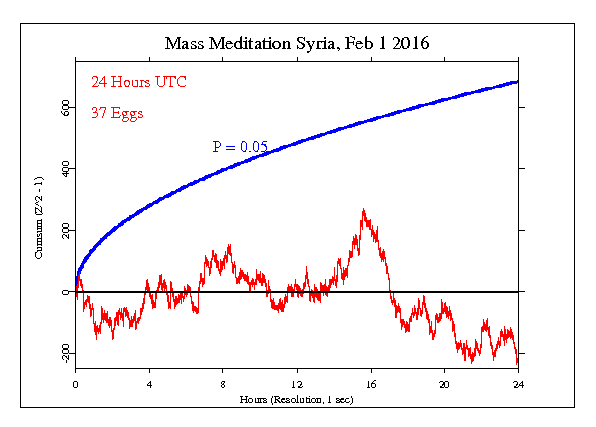Meditation for Syria, Feb 1 2016
Published on Jan 24, 2016
On February 1, 2106, millions of people will participate in one of the largest and most important synchronized meditations in history. James Twyman, The Peace Troubadour, will walk into a Syrian village, within eyesight of ISIS, along with leaders from Judaism, Christianity and Islam, and a local Druze leader, to sing prayers of peace while millions of people "Pulse" the region with harmonic energy. Please join us. Go to www.WorldPeacePulse.com to register, and we will send the exact time of the vigil on January 31st.
Specific Hypothesis and Results
The GCP event was set for the full 24 hour day, since this was billed as a mass meditation, inviting people all around the world to join in. The result was Chisquare 86145.8938 on 86400 df for p = 0.610 and Z = -0.729
Interpretation
The following graph is a visual display of the statistical result. It shows the second-by-second accumulation of small deviations of the data from what’s expected. Our prediction is that deviations will tend to be positive, and if this is so, the jagged line will tend to go upward. If the endpoint is positive, this is evidence for the general hypothesis and adds to the bottom line. If the endpoint is outside the smooth curve showing 0.05 probability, the deviation is nominally significant. If the trend of the cumulative deviation is downward, this is evidence against the hypothesis, and is subtracted from the bottom line. For more detail on how to interpret the results, see The Science and related pages, as well as the standard caveat below.

Standard caveat
It is important to keep in mind that we have only a tiny statistical effect, so that it is always hard to distinguish signal from noise. This means that every success
might be largely driven by chance, and every null
might include a real signal overwhelmed by noise. In the long run, a real effect can be identified only by patiently accumulating replications of similar analyses.
